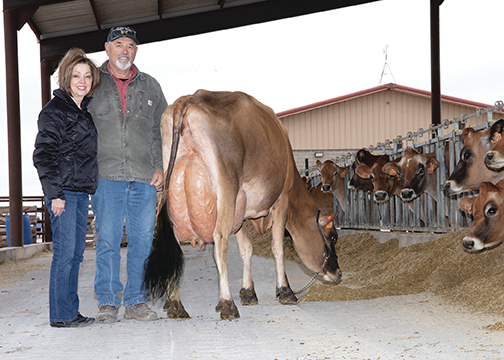
They say competition drives innovation, and that’s exactly what’s happening in Hobbs, N.M. at Goff Dairy. Buster and
Beverly Goff, their son Jason, and grandson Colton Armstrong own and operate neighboring dairies. One is comprised of Registered
Holsteins, the other of Registered Jerseys, both milking 5,500 head. Jason manages the Holstein herd while Buster and Colton manage the Jersey farm. Even though the makeup of the two farms is different, each has the same goal – to be as profitable as possible with the resources available. Built in 1998, the Goff Holstein herd is milked in a double-50 parallel parlor, averaging 98 pounds
of fat corrected milk and 4.0% fat. The Goffs’ Jersey herd is milked in a 72-stall rotary parlor constructed in 2006, and averages 80 pounds of fat corrected milk with 5.5% fat and 3.8% protein. Both herds are milked twice per day and housed
in open lot paddocks. Feed for both facilities is raised jointly on 3,200 acres of pivot-irrigated cropland.
Why two different dairies with two different breeds? “When we initially built, milk pricing was based on fluid volume, but component pricing came to our market in the early 2000s, just as we were looking to expand. It was the incentive we needed
to start with Jerseys,” says Buster. “Having two different herds is kind of a natural hedge on markets. One dairy is more feed efficient. When feed is high and milk is low, but components are high, the Jerseys thrive. When fluid milk prices
are high, the Holsteins do a little better.”
Profitability is the ultimate goal. “Every cow here has to be profitable and that means using the kind of genetics that put milk in the tank. Production is our number one goal,” says Buster. “But, we like good looking cattle too.
I’m in the corrals every day; I don’t like to look at ugly cows.” With a breeding philosophy that stresses the importance of quality mammary systems and sound feet and legs, the Goffs focus on cow families to prolong the herd’s
longevity. “Sound cows with good feet and legs and quality udders rarely end up in the hospital pen and stick around.”
“The team at Goff’s have outlined their goals and painted a picture of their desired cow for each facility,” says Stuart Schooley, district sales manager, Select Sires Member Cooperative. “The next step is identifying the sires
that will create the next generation. We focus on linear traits to achieve balanced, well attached mammary systems while also honing in on component levels, fertility and some health traits to make long-lasting cows.” Included in the current
lineup of mating sires at Goff Dairy is
614JE2222 JX INXS {6}, the No. 4 Herd Health Profit Dollars
® (HHP$
®) young sire in the breed.
As well as consistently breeding a more profitable cow, the Goffs look for ways to improve management and facilities to bolster their bottom line. “You have to stay current, or you’re going backwards. We’re always looking at what
the industry is presenting. We’re a bottom-line dairy. If cutting-edge works for us, we’ll implement it.” says Buster. With feed costs accounting for the majority of expenses on most dairies, the Goffs reevaluated their feed
storage facilities, focusing on feed shrink. In doing so they made the decision to build new commodity storage, transitioning from open-faced barns to fully enclosed. The building project took less than two years to pay for itself in reduced feed
shrink savings.
Advancements in technology have helped the farm gain efficiencies as well. “It’s getting harder and harder to find people who are good cattlemen,” says Buster. “It’s easy to find good employees, but more difficult to find
people who truly understand the cows.” To help address this challenge, the Goffs implemented a cow monitoring system which has helped them monitor herd health more closely without increasing labor costs.
With no more room to grow in cow numbers or acreage, Buster knows they need to maximize their facilities and genetics to continue being profitable. “We can’t grow in numbers, but we can produce more milk per cow and do more with what we
have. Our genetics advance and increase our production each year. We will continue to focus and concentrate on those genetics.”
